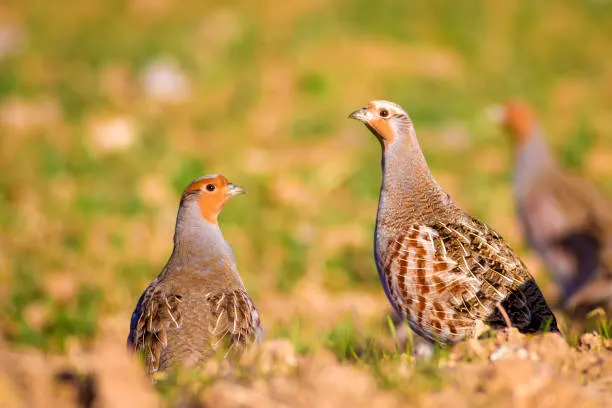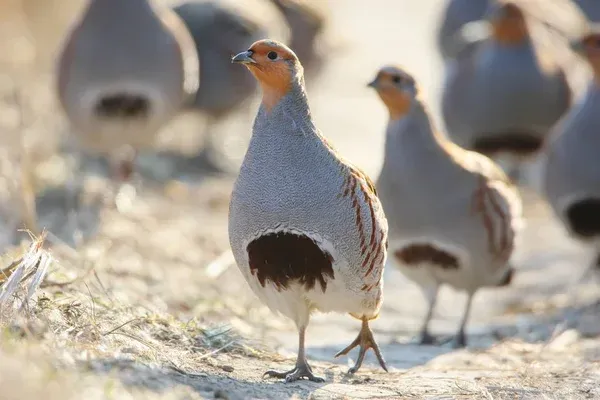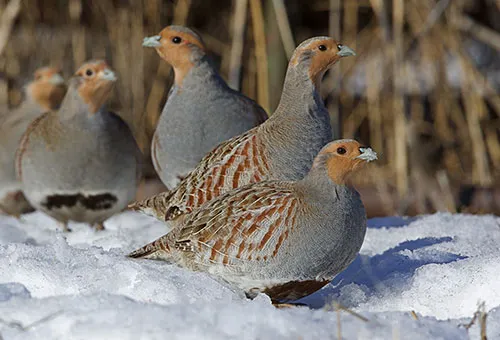Surprising Facts About Partridges

Partridges may not be as famous as peacocks or eagles, but these ground-loving birds are fascinating in their own right. Known from nursery rhymes (“a partridge in a pear tree”) and favored game birds across Europe and Asia, partridges are resilient, clever, and important parts of many ecosystems. This article dives into interesting and detailed facts about partridges—their lifestyle, behavior, diet, and how they survive in the wild.
What Is a Partridge?
- Family: Phasianidae (same family as pheasants, chickens, and quails)
- Common Types: Grey Partridge (Perdix perdix), Red-legged Partridge (Alectoris rufa), Chukar Partridge (Alectoris chukar)
- Habitat: Native to Europe, Asia, and parts of Africa; introduced in North America and New Zealand

Fascinating Partridge Facts
- They Don’t Perch in Pear Trees.
Despite the song lyric, partridges are ground birds. They rarely fly, preferring to walk or run and usually nest on the ground in grassy or scrubby areas. - Excellent Camouflage Artists.
Partridges have earth-toned feathers—gray, brown, or red—allowing them to blend into the underbrush and avoid predators like foxes or hawks. - Short, Powerful Flights.
Although not long-distance fliers, partridges can burst into short, rapid flight when startled. This explosive takeoff is often their last defense when escape by running fails. - Loyal to Their Territories.
Partridges are non-migratory and often stay in the same area year-round. They form coveys (small family groups) outside the breeding season. - Distinctive Whistling Calls.
Partridges communicate through various high-pitched whistles and clucks, especially to signal alarm or call chicks. - Impressive Reproductive Strategy.
A female partridge can lay up to 15–20 eggs in a single clutch, one of the highest among birds. She incubates the eggs while the male stands guard. - Precocial Chicks.
Partridge chicks hatch with open eyes, feathers, and the ability to walk within hours. They begin following their parents and feeding themselves almost immediately. - Omnivorous Diet.
Partridges feed on seeds, grains, insects, and small invertebrates. Chicks need protein-rich insect diets during the first few weeks. - Covey Formation in Winter.
After breeding season, partridges form groups (coveys) to stay warm, forage together, and reduce predation risk. These coveys often consist of extended family. - Natural Pest Controllers.
In agricultural areas, partridges help by consuming harmful insects, making them beneficial to farmers and ecosystems alike.
Cultural Significance
- The “partridge in a pear tree” from The Twelve Days of Christmas is believed to symbolize self-sacrifice and spiritual awakening.
- In hunting traditions, especially in Europe, partridges are valued game birds, bred and released for sporting purposes.
Threats and Conservation
Partridge populations have been declining in parts of Europe and Asia due to:
- Habitat loss from intensive agriculture
- Pesticide use, which reduces insect populations needed for chicks
- Hunting pressure in unmanaged areas
- Predation by introduced species like cats and foxes
Conservation efforts focus on habitat restoration, creating wildlife-friendly farmlands, and limiting hunting during breeding seasons.
Quick Facts Recap
| Fact | Details |
|---|---|
| Scientific Family | Phasianidae |
| Nesting Style | Ground-nesters |
| Number of Eggs | Up to 20 per clutch |
| Main Diet | Seeds, grains, insects |
| Flight | Short bursts, rarely long-distance |
| Lifespan | 2–4 years in the wild |
| Group Name | Covey |
| Native Range | Europe, Asia, parts of Africa |

Conclusion
Partridges are much more than just a line in a holiday tune. These ground-dwelling birds live rich and dynamic lives, marked by clever camouflage, strong family bonds, and impressive survival strategies. Whether strutting through grasslands or whistling to their chicks, partridges remain an essential part of natural and cultural landscapes alike.



